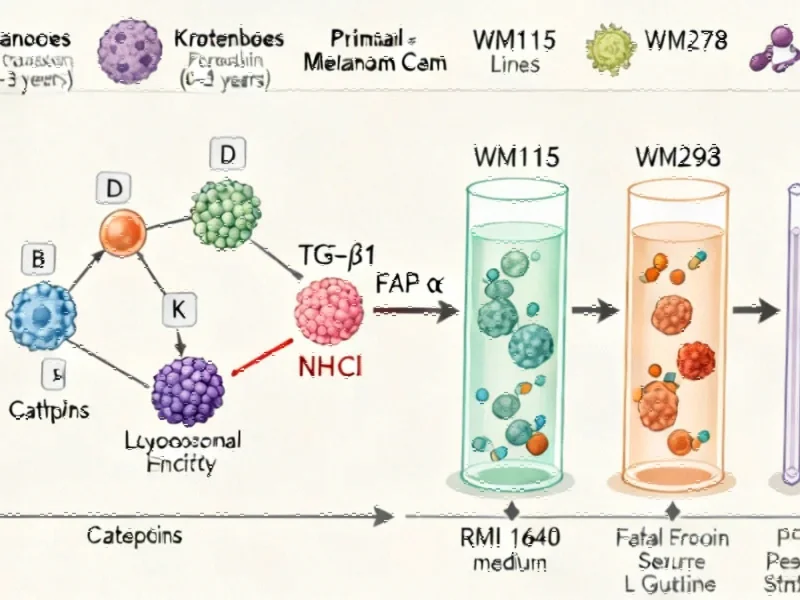UV Radiation Activates Molecular Pathway Driving Melanoma Spread
Recent research published in the British Journal of Cancer has uncovered the precise molecular mechanism through which ultraviolet radiation promotes the spread of melanoma, the most dangerous form of skin cancer. According to the report, UV exposure triggers a sequential reaction involving cathepsins, TGF-β1, and FAP-α that facilitates cancer metastasis.
The study states that this discovery provides crucial insights into how sunlight exposure translates into increased cancer risk at the cellular level. Sources indicate that understanding this pathway could lead to new therapeutic approaches for preventing melanoma progression.
Comprehensive Experimental Approach
Researchers conducted multiple experiments using human cell lines and zebrafish models to map the metastatic pathway. The team utilized four primary melanocyte lines alongside keratinocytes and fibroblasts obtained from Caucasian donors through foreskin circumcisions with parental consent.
Analysts suggest the experimental design was particularly thorough, incorporating microarray analysis to examine gene expression patterns in both young and senescent cell cultures. The research team processed raw data using specialized software and deposited their findings in the Gene Expression Omnibus database under accession number GSE83922.
Key Molecular Players Identified
The report identifies three critical components in the UV-induced metastasis pathway. First, UV radiation activates cathepsin enzymes, which in turn stimulate transforming growth factor-beta 1 (TGF-β1). This growth factor then triggers fibroblast activation protein-alpha (FAP-α), ultimately driving cancer cell invasion and dissemination.
Researchers used specific inhibitors and antibodies to block each component of this pathway, confirming their roles in metastasis. The study employed various primary and secondary antibodies from multiple manufacturers to detect and quantify protein expression.
Multiple Model Systems Confirm Findings
Scientists validated their discoveries across several experimental systems, including three-dimensional skin constructs that mimic human tissue architecture. These constructs contained fibroblast-collagen matrices with layers of keratinocytes and melanocytes forming an epidermis-like structure.
The research team also used zebrafish embryos to study metastasis in living organisms. According to reports, melanoma cells pre-labeled with fluorescent dye were injected into zebrafish and tracked after UV exposure, with results showing that blocking FAP-α significantly reduced cancer spread.
Statistical Analysis and Data Processing
Researchers performed comprehensive statistical evaluations using specialized software, with all p-values below 0.05 considered significant. The team utilized R programming language for hierarchical clustering and heat map generation, applying Euclidean similarity measures with Ward’s linkage rule.
This rigorous analytical approach comes amid broader industry developments in data processing and analysis methodologies. The findings contribute to growing understanding of cellular mechanisms that could influence future related innovations in medical research.
Potential Therapeutic Implications
The identification of this sequential pathway opens new possibilities for intervention strategies. Sources indicate that targeting cathepsins, TGF-β1, or FAP-α could potentially block UV-induced melanoma metastasis before it begins.
This research emerges alongside other recent technology breakthroughs that are expanding scientific understanding of material and biological systems. The study’s methodology reflects sophisticated approaches to investigating complex biological processes, similar to advances seen in market trends toward more precise analytical techniques.
Future Research Directions
While the current study provides significant insights, researchers note that additional investigation is needed to fully translate these findings into clinical applications. The report suggests that understanding how this pathway interacts with other cellular processes will be crucial for developing effective treatments.
The research team emphasized that their work represents an important step toward addressing the significant health challenge posed by metastatic melanoma, which remains difficult to treat once it has spread beyond the primary tumor site.
This article aggregates information from publicly available sources. All trademarks and copyrights belong to their respective owners.
Note: Featured image is for illustrative purposes only and does not represent any specific product, service, or entity mentioned in this article.



